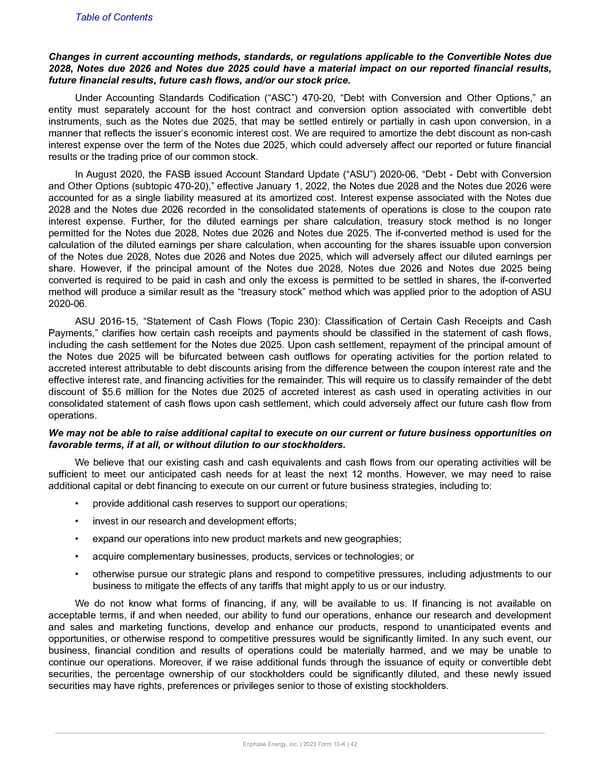Table of Contents Changes in current accounting methods, standards, or regulations applicable to the Convertible Notes due 2028, Notes due 2026 and Notes due 2025 could have a material impact on our reported financial results, future financial results, future cash flows, and/or our stock price. Under Accounting Standards Codification (“ASC”) 470-20, “Debt with Conversion and Other Options,” an entity must separately account for the host contract and conversion option associated with convertible debt instruments, such as the Notes due 2025, that may be settled entirely or partially in cash upon conversion, in a manner that reflects the issuer’s economic interest cost. We are required to amortize the debt discount as non-cash interest expense over the term of the Notes due 2025, which could adversely affect our reported or future financial results or the trading price of our common stock. In August 2020, the FASB issued Account Standard Update (“ASU”) 2020-06, “Debt - Debt with Conversion and Other Options (subtopic 470-20),” effective January 1, 2022, the Notes due 2028 and the Notes due 2026 were accounted for as a single liability measured at its amortized cost. Interest expense associated with the Notes due 2028 and the Notes due 2026 recorded in the consolidated statements of operations is close to the coupon rate interest expense. Further, for the diluted earnings per share calculation, treasury stock method is no longer permitted for the Notes due 2028, Notes due 2026 and Notes due 2025. The if-converted method is used for the calculation of the diluted earnings per share calculation, when accounting for the shares issuable upon conversion of the Notes due 2028, Notes due 2026 and Notes due 2025, which will adversely affect our diluted earnings per share. However, if the principal amount of the Notes due 2028, Notes due 2026 and Notes due 2025 being converted is required to be paid in cash and only the excess is permitted to be settled in shares, the if-converted method will produce a similar result as the “treasury stock” method which was applied prior to the adoption of ASU 2020-06. ASU 2016-15, “Statement of Cash Flows (Topic 230): Classification of Certain Cash Receipts and Cash Payments,” clarifies how certain cash receipts and payments should be classified in the statement of cash flows, including the cash settlement for the Notes due 2025. Upon cash settlement, repayment of the principal amount of the Notes due 2025 will be bifurcated between cash outflows for operating activities for the portion related to accreted interest attributable to debt discounts arising from the difference between the coupon interest rate and the effective interest rate, and financing activities for the remainder. This will require us to classify remainder of the debt discount of $5.6 million for the Notes due 2025 of accreted interest as cash used in operating activities in our consolidated statement of cash flows upon cash settlement, which could adversely affect our future cash flow from operations. We may not be able to raise additional capital to execute on our current or future business opportunities on favorable terms, if at all, or without dilution to our stockholders. We believe that our existing cash and cash equivalents and cash flows from our operating activities will be sufficient to meet our anticipated cash needs for at least the next 12 months. However, we may need to raise additional capital or debt financing to execute on our current or future business strategies, including to: • provide additional cash reserves to support our operations; • invest in our research and development efforts; • expand our operations into new product markets and new geographies; • acquire complementary businesses, products, services or technologies; or • otherwise pursue our strategic plans and respond to competitive pressures, including adjustments to our business to mitigate the effects of any tariffs that might apply to us or our industry. We do not know what forms of financing, if any, will be available to us. If financing is not available on acceptable terms, if and when needed, our ability to fund our operations, enhance our research and development and sales and marketing functions, develop and enhance our products, respond to unanticipated events and opportunities, or otherwise respond to competitive pressures would be significantly limited. In any such event, our business, financial condition and results of operations could be materially harmed, and we may be unable to continue our operations. Moreover, if we raise additional funds through the issuance of equity or convertible debt securities, the percentage ownership of our stockholders could be significantly diluted, and these newly issued securities may have rights, preferences or privileges senior to those of existing stockholders. Enphase Energy, Inc. | 2023 Form 10-K | 42
 Annual Report Page 41 Page 43
Annual Report Page 41 Page 43